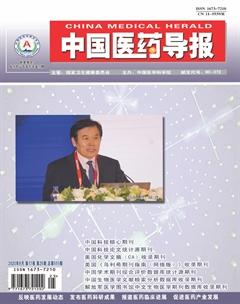β中间型地中海贫血患者血清铁调素、转化生长因子15和铁蛋白相关性研究
雷宇 曾清 程纬民


[摘要] 目的 分析血清铁调素、转化生长因子(GDF15)以及血清铁蛋白(SF)在β中间型地中海贫血(β-TI)患者体内相关性。 方法 采用分层抽样办法,选取2016年9月—2019年3月广西中医药大学第一附属医院(以下简称“我院”)血液科门诊经酶联免疫吸附测定(ELISA)方法和聚合酶链反应(PCR)技术确诊基因为β-TI患者56例作为β-TI组及2018年11月—2019年3月来我院体检科体检者68名作为健康对照组,对两组血清铁调素及SF和GDF15水平进行分析。 结果 健康对照组中女性血红蛋白(Hb)、铁调素以及SF均低于男性,差异均有统计学意义(均P < 0.05)。男性和女性GDF15比较,差异无统计学意义(P > 0.05)。在β-TI组中,男性和女性Hb、铁调素、GDF15、SF比较,差异无统计学意义(P > 0.05)。β-TI组Hb、铁调素均低于健康对照组,而GDF15以及SF均高于健康对照组,差异均有统计学意义(均P < 0.05)。β-TI组铁调素和GDF15呈负相关(r = -0.25),GDF15和Hb呈负相关(r = -0.24),GDF15和SF呈负相关(r = -0.28),SF和年龄呈正相关(r = 0.36);健康对照组中GDF15和铁调素呈正相关(r = 0.26),SF和铁调素呈正相关(r = 0.34),GDF15和SF呈正相关(r = 0.36),相关性均有统计学意义(均P < 0.05)。 结论 β-TI患者血清铁调素水平明显下降,而GDF15和SF显著升高,GDF15可能是β-TI患者铁调素重要调节因素。
[关键词] 铁代谢;铁调素;地中海贫血;转化生长因子15
[中图分类号] R556.61 [文獻标识码] A [文章编号] 1673-7210(2020)09(a)-0100-04
[Abstract] Objective To analyze the correlation of serum hepcidin, growth differentiation factor 15 (GDF15) and serum ferritin (SF) in β-thalassemia intermedia (β-TI) patients. Methods Using stratified sampling method, a total of 56 patients with β-TI confirmed by enzyme-linked immunosorbent assay (ELISA) and polymerase chain reaction (PCR) from September 2016 to March 2019 in the Department of Hematology, the First Affiliated Hospital of Guangxi University of Chinese Medicine (hereinafter referred to as “our hospital”) were selected as the β-TI group and a total of 68 patients who came to the Physical Examination Department of our hospital from November 2018 to March 2019 were selected as the healthy control group. Serum hepcidin and SF and GDF15 levels were analyzed in the two groups. Results In the healthy control group, hemoglobin (Hb), hepcidin and SF were all lower in females than in males, and the differences were statistically significant (all P < 0.05). There was no significant difference in GDF15 between male and female (P > 0.05). In β-TI group, there were no significant differences in Hb, hepcidin, GDF15 and SF between male and female (P > 0.05). In β-TI group, Hb and hepcidin were lower than those in the healthy control group, while GDF15 and SF were higher than those in the healthy control group, and the differences were statistically significant (all P < 0.05). In β-TI group, hepcidin was negatively correlated with GDF15 (r = -0.25), GDF15 was negatively correlated with Hb (r = -0.24), GDF15 was negatively correlated with SF (r = -0.28), and SF was positively correlated with age (r = 0.36); In the healthy control group, GDF15 was positively correlated with hepcidin (r = 0.26), SF was positively correlated with hepcidin (r = 0.34), GDF15 was positively correlated with SF (r = 0.36), and the correlation was statistically significant (all P < 0.05). Conclusion In β-TI patients, serum hepcidin levels are significantly decreased, while GDF15 and SF are significantly increased. GDF15 may be an important regulatory factor of hepcidin in β-TI patients.
鐵调素在巨噬细胞、心肝肾、小肠等多种细胞有表达,其可以通过磷酸化降解细胞膜表面的膜铁转运蛋白减少铁释放和抑制铁吸收达到减少血清铁浓度的作用[7-9]。炎症刺激、铁过量可以促进铁调素表达,而缺铁、缺氧以及无效红细胞生成过程的各种因子可下调铁调素表达[10-15]。
本研究提示铁调素和SF在健康人群存在性别差异,女性铁调素和SF均低于男性,而GDF15浓度在健康男性和女性之间差异无统计学意义(P > 0.05)。从关联性分析看出,健康人体内铁调素和SF呈正相关(r = 0.34)。尽管女性月经会丢失铁,但是红细胞会代偿避免贫血,而GDF15未见明显升高可以理解为生理范围内的代偿。健康人群SF和GDF15呈正相关(r = 0.36),这也侧面说明了红系生成数量对铁的需求和SF的关联性。这似乎暗示着在铁稳态的情况下,健康人体内调控铁调素的主要调节途径还是在存储铁这一方。
本研究关联性分析显示在β-TI患者体内SF和年龄呈正相关(r = 0.36),这也提示在未祛铁时随着时间的推移这类患者不可避免发生自发性铁过载。β-TI组GDF15和Hb呈负相关(r = -0.24),从临床分析Hb偏高的患者骨髓红系祖细胞分化压力相对偏低,因此释放GDF15蛋白偏低,高Hb常常伴随着GDF15的低表达,反之红细胞前体对铁的需求下降,肠道吸收铁减少,因此GDF15和SF呈负相关(r = -0.28)。
β-TI患者本身就不太需要输血,大多数患者Hb基本能稳定维持在90 g/L左右,这类患者铁调素本身低于健康人群,铁调素不足又加重肠道吸收铁,因此β-TI患者体内处于“铁失衡加速”状态。不同于健康人群,在铁稳态严重破坏的β地贫患者体内,铁调素调控受到贫血、缺氧、红系生成和铁过载等多种调控因素的影响[16-17]。
本研究提示β-TI组铁调素要显著低于健康对照组,相反的是GDF15要显著高于健康对照,而且β-TI组铁调素和GDF15负相关(r = -0.25),这个数据也印证了Tanno等[18]的研究:地贫患者血清高表达GDF15蛋白显著抑制铁调素的表达,而当通过免疫共沉淀祛除GDF15时,铁调素抑制解除而显著升高。和国外Origa等[19]报道一致发现:β-TI组高表达GDF15同时伴随着铁调素显著降低。这个现象笔者认为和骨髓内大量无效红细胞生成过程中释放出红系因子如促红细胞生成素、GDF15等抑制铁调素有密切关系。
β-TI地贫患者体内存在着大量的无效红细胞生成,大量的原幼红细胞在髓内凋亡后大量的铁再次释放,机体贫血和缺氧再次诱导骨髓分化大量原始红细胞,进而形成机体贫血缺氧-原幼红分化后髓内凋亡-机体贫血缺氧循环。而在这个过程中大量的红细胞生成需要大量的铁,肠道铁吸收比正常人群显著升高[10-11]。
β-TI患者体内一方面存在的无效红细胞生成,肠道吸收铁增加同时另一方面低铁调素状态下对肠道铁吸收的抑制远不及正常人,在双重作用下患者即使不输血也容易随着年龄的增长从而出现铁过载。对于这类患者要加强对患者机体铁负荷的检测,以便及早发现铁过载及时进行祛铁治疗。另外目前通过铁调素的相关通道和组织途径抑制研究发现,给予铁调素促进剂可以促进体内铁调素的表达,从而减轻机体铁过载,相关的研究已经在动物模型中得到验证[12]。
本研究提示,β-TI患者体内铁调素和Hb无关,与机体红系生成GDF15有关。GDF15可能是通过某些途径参与抑制铁调素的调控铁代谢的因子,目前已有相关临床实验发现纠正无效造血可以减少铁调素的抑制[20],体外补充铁调素或者相关通路的调控抑制剂已经进入临床实验,希望将来能成为治疗各种铁过载疾病一种重要手段。
[参考文献]
[1] Weatherall DJ. The definition and epidemiology of non-transfusion-dependent thalassemia [J]. Blood Rev,2012, 26 Suppl 1:S3-S6.
[2] 刘容容.铁过载对地中海贫血患者造血功能的损伤和机制研究[J].广西医科大学学报,2019,36(6):1018-1021.
[3] Sagar CS,Kumar R,Sharma DC,et al. DNA damage:beta zero versus beta plus thalassemia [J]. Ann Hum Biol,2015, 42(6):585-588. doi:10.3109/03014460.2014.990921.
[4] Huang Y,Liu R,Wei X,et al. Erythropoiesis and Iron Homeostasis in Non-Transfusion-Dependent Thalassemia Patients with Extramedullary Hematopoiesis [J]. Biomed Res Int,2019,2019:4504302. doi:10.1155/2019/4504302.
[5] Stockwell BR,Friedmann Angeli JP,Bayir H,et al. Ferroptosis:A Regulated Cell Death Nexus Linking Metabolism,Redox Biology,and Disease [J]. Cell,2017,171(2):273-285. doi:10.1016/j.cell.2017.09.021.
[6] De Franceschi L,Bertoldi M,Matte A,et al. Oxidative stress and β-thalassemic erythroid cells behind the molecular defect [J]. Oxid Med Cell Longev,2013,2013:985210.doi:10.1155/2013/985210.
[7] Park CH,Valore EV,Waring AJ,et al. Hepcidin,a urinary antimicrobial peptide synthesized in the liver [J]. J Biol Chem,2001,276(11):7806-7810. doi:10.1074/jbc.M008922200.
[8] Theurl I,Theurl M,Seifert M,et al. Autocrine formation of hepcidin induces iron retention in human monocytes [J]. Blood,2008,111(4):2392-2399. doi:10.1182/blood-2007-05-090019.
[9] Brookes MJ,Sharma NK,Tselepis C,et al. Serum pro-hepcidin:measuring active hepcidin or a non-functional precursor? [J]. Gut,2005,54(1):169-170. doi:10.1136/gut.2004.047639.
[10] Viatte L,Vaulont S. Hepcidin,the iron watcher [J]. Biochimie,2009,91(10):1223-1228. doi:10.1016/j.biochi.2009. 06.012.
[11] 王璐,張倩,韩冰.无效造血与铁过载[J].基础医学与临床,2014,34(1):121-124.
[12] Ashby DR,Gale DP,Busbridge M,et al. Erythropoietin administration in humans causes a marked and prolonged reduction in circulating hepcidin [J]. Haematologica,2010,95(3):505-508. doi:10.3324/haematol.2009.013136.
[13] 邹汉良,陈丕绩,黄玉佳,等.珠蛋白生成障碍性贫血基因携带者红细胞生成与铁调素的相关性研究[J].国际检验医学杂志,2012,33(9):1037-1039.
[14] Anderson ER,Taylor M,Xue X,et al. Intestinal HIF2α promotes tissue-iron accumulation in disorders of iron overload with anemia [J]. Proc Natl Acad Sci U S A,2013, 110(50):E4922-E4930. doi:10.1073/pnas.1314197110.
[15] Li H,Choesang T,Bao W,et al. Decreasing TfR1 expression reverses anemia and hepcidin suppression in β-thalassemic mice [J]. Blood,2017,129(11):1514-1526. doi:10.1182/blood-2016-09-742387.
[16] Chutvanichkul B,Vattanaviboon P,Mas-Oodi S,et al. Labile iron pool as a parameter to monitor iron overload and oxidative stress status in β-thalassemic erythrocytes [J]. Cytometry B Clin Cytom,2018,94(4):631-636. doi:10. 1002/cyto.b.21633.
[17] Guimares JS,Cominal JG,Silva-Pinto AC,et al. Altered erythropoiesis and iron metabolism in carriers of thalassemia [J]. Eur J Haematol,2015,94(6):511-518. doi:10.1111/ejh.12464.
[18] Tanno T,Bhanu NV,Oneal PA,et al. High levels of GDF15 in thalassemia suppress expression of the iron regulatory protein hepcidin [J]. Nat Med,2007,13(9):1096-1101. doi:10.1038/nm1629.
[19] Origa R,Cazzola M,Mereu E,et al. Differences in the erythropoiesis-hepcidin-iron store axis between hemoglobin H disease and β-thalassemia intermedia [J]. Haematologica,2015,100(5):e169-e171. doi:10.3324/haematol.2014.115733.
[20] Dussiot M,Maciel TT,Fricot A,et al. An activin receptor IIA ligand trap corrects ineffective erythropoiesis in β-thalassemia [J]. Nat Med,2014,20(4):398-407. doi:10.1038/nm.3468.
(收稿日期:2019-12-17)

